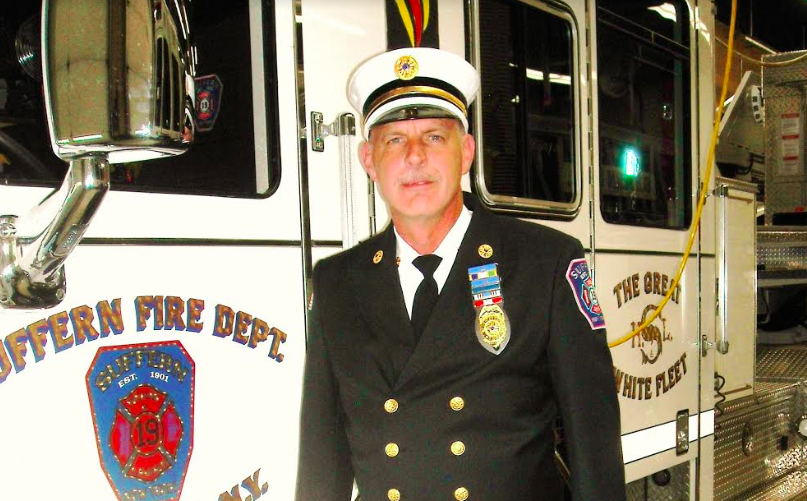
BY BARRY WARNER
Our Unsung Hero this week is volunteer Michael Stark, who has attained the rank of ex-chief with over 20 years of service and heads the driver training program.
“The driver training program, under the direction of Michael Stark, is critical to our department as it teaches our new firefighters to maintain, drive and use our apparatus with confidence,” said Captain Matthew Ellsworth. “He continuously maintains the top 5 percent of participation in events and fires, as well as spends months out of the year to teach our new drivers.”
“A tiller truck, also known as a tractor-drawn aerial tiller ladder or hook and ladder truck, is a specialized turntable ladder mounted on a semi-trailer truck. One of the main features of the tiller truck is its enhanced maneuverability. The Tillerman maintains a rear-steering position in an elevated cabin, because the back-end is a trailer that steers independently of the front-end of the truck. Because the tiller operator is much higher than the driver, he can provide a second set of eyes for traffic at intersections, positioning the turntable and indicating wires that are ahead of the vehicle. The aerial ladder stretches 100 feet in length and is hydraulically powered. It’s mounted to the apparatus on a turnstile that allows it to rotate direction. The second steering wheel is used to steer the rear wheels in order to better navigate through tight traffic conditions and to more precisely position the truck for raising the ladder,” Michael Stark told the Rockland County Times.
“The tools and ladders carried on the aerial ladder truck are most often used at fires to perform a task known as ventilation. This action involves the Tillerman climbing to the roof of the building to cut holes that allow much of the heat and smoke inside the burning building to escape,” Stark continued. “Doing this improves conditions for firefighters inside who’re trying to extinguish the fire and locate any victims. The Tillerman’s training log includes the following skills to be mastered: starting the truck, emergency engine shutdown, seat belt used, right turns, left turns, stay in lane, communication with driver, backing, parking, scene positioning, hydraulic generator, master stream ops, out-rigger setup, turntable controls, aerial ladder ops, engine failure ops, back-up systems, compartments, tires, fueling and engine maintenance.”
Ventilation is a part of structural firefighting tactics and involves the expulsion of heat and smoke from a fire building, permitting the firefighters to more easily and safely find trapped individuals and attack the fire. If a large fire is not properly vented, not only will it be much harder to fight, it could also build up enough poorly burned smoke to create a smoke explosion, or create enough heat to create a flashover. Poorly placed or timed-ventilation may increase the fire’s air supply, causing it to grow and spread rapidly. Vertical ventilation takes place through holes cut in the roof during the early stages of a fire in a process known as roof operations, while horizontal ventilation usually takes place through doors and windows. The goal of each is to clear heat and smoke to increase the chances of survival for trapped occupants, so that water lines can be advanced into the structure to more effectively battle the flames.
The tractor-drawn aerial is the most maneuverable aerial apparatus, even though it’s much longer that a straight-frame aerial. It can navigate around obstacles and get in and out of tighter congested areas. This gives it the ability to steer into locations that a straight-frame aerial is unable to navigate. This capability provides the opportunity to get closer to a structure for firefighter access or victim rescue because it is:
1 Highly maneuverable because of the fifth wheel articulation and the ability to steer the rear of the trailer around obstacles.
2 More maneuverable than a straight-frame aerial, even though the tractor-drawn aerial is longer.
3 More maneuverable responding in and around narrow streets, traffic circles, parked cars and cul-de-sacs.
4 More maneuverable, so that the turntable on the tractor-drawn aerial can be manipulated closer to buildings, compared to a straight-frame aerial.
5 Able to navigate into urban development areas with tight access to apartment complexes, condos, offices and college campuses.
Compartment capacity for a tractor-drawn aerial can be between 500-650 cubic feet compared to a straight-frame aerial compartment capacity of 160 cubic feet. Tractor-drawn aerials accommodate a larger number of ground ladders than straight-frame aerials. Because tractor-drawn aerials are mid-mount aerials, the structural components for the turntable are located towards the front of the apparatus, providing for a larger space for ground ladders in the back of the trailer.
“I started in the fire service when I joined the Valley Cottage Fire Department, then joined the West Haverstraw Fire Department when I lived in Garnerville, and when I got married, I moved to Suffern and joined the Suffern Hook and Ladder Co. No. 1.,” Stark concluded. “Suffern is a great place to live. My son is currently a member of the department. The Suffern Village Board has been a supporter of the Fire Department 100 percent. You never know when the next fire will strike, so firefighters have to participate in training, such as extrication, driving and ladder drills, in order to be ready. I have always enjoyed firefighting and the camaraderie of the guys in the department.”
For information about volunteering for the Suffern Hook and Ladder Co. No. 1, call 845-357-6066 or visit www.suffernfire.org.

You must be logged in to post a comment Login